When a dairy cow in the United States is given antibiotics for an illness, its milk is discarded until the drug clears its system. Since most dairies have dozens or even hundreds of cows, the lost milk from one or two is scarcely noticed.
On small dairy farms in Peru, however, where a farmer may own only a few cows, withholding several days’ milk from a treated animal takes a much greater financial toll. The temptation to continue selling milk containing antibiotic residues can be great.
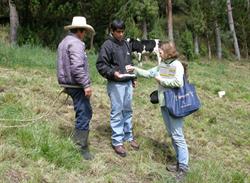 Given the important public health consequences of antibiotic use in food production animals, Laurel Redding thought it was a topic worth investigating. “In veterinary medicine, and in production medicine in particular, antibiotics are a particularly hot topic nowadays,” said Redding, a student in the VMD-PhD program at the University of Pennsylvania’s School of Veterinary Medicine and Perelman School of Medicine.
Given the important public health consequences of antibiotic use in food production animals, Laurel Redding thought it was a topic worth investigating. “In veterinary medicine, and in production medicine in particular, antibiotics are a particularly hot topic nowadays,” said Redding, a student in the VMD-PhD program at the University of Pennsylvania’s School of Veterinary Medicine and Perelman School of Medicine.
However, few people have studied antibiotic use on small farms in developing countries. As Redding noted, “In many parts of low- and middle-income countries, the majority of the population is employed in farming on small farms.”
For seven months in 2012 and 2013, Redding traveled around Cajamarca in the northern highlands of Peru, surveying dairy farmers, veterinarians, and others involved in the dairy industry. Her research explored the extent of antibiotic use, how educated farmers were about using drugs in their animals, and how much of those drugs were making their way into the milk and milk product supply in the area. What she found is telling of the challenges of making a living in these remote and often impoverished areas, and of the significant role that veterinarians can play in protecting animal and human health around the world.
Aside from owning and riding horses and some work on stud farms, Redding did not have much of a background in large animals, much less agriculture, when she arrived at Penn Vet eight years ago. But through her dual-degree program under the mentorship of faculty members Dr. Gary Smith, Professor of Population Biology and Epidemiology, and Dr. David Galligan, Professor of Animal Health Economics, she developed a joint passion for food production and the developing world—with veterinary medicine being the thread connecting the two. She chose to pursue her PhD in the Center for Clinical Epidemiology and Biostatistics at Penn Medicine, with a focus on the use of drugs across large populations of animals. She found an ideal advisor in Dr. Sean Hennessy, Associate Professor of Pharmacology in the medical school.
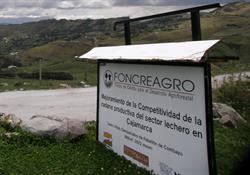 Dr. Jorge Guerrero, an adjunct professor at Penn Vet, connected Redding with the nonprofit organization Foncreagro, which supports Peruvian farmers with veterinary care and other assistance. The organization helped her launch and carry out her research projects. She also worked with a research assistant who was a vet student in the region.
Dr. Jorge Guerrero, an adjunct professor at Penn Vet, connected Redding with the nonprofit organization Foncreagro, which supports Peruvian farmers with veterinary care and other assistance. The organization helped her launch and carry out her research projects. She also worked with a research assistant who was a vet student in the region.
Characterized by small farms, Peru’s Cajamarca is one of the country’s major dairy-producing regions. Most farms have fewer than 15 cattle. Roughly 60 percent of the milk produced in the region goes to large milk-processing companies, collected by milk trucks that visit the farms twice a day. Thirty percent goes to cheese producers and the remaining 10 percent is sold on the open market, often in roadside stands where farmers ladle milk into plastic bags for waiting customers.
As Redding discovered, farmers in Cajamarca typically obtain antibiotics either directly from veterinarians who travel to the farms (and who are supported by Foncreagro) or from feed stores. They use the drugs to treat cows for mastitis and other reproductive illnesses as well as for diarrhea.
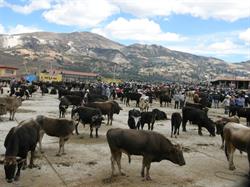 In dairy cows, antibiotics can prove extremely useful for preventing and treating infections, leading to improvement in overall health and productivity. Yet their use promotes the rise of resistant strains of bacteria on the farms, putting workers at risk of infection from these tenacious bugs. In addition, allergies, toxicity, and antibiotic resistance can result if people consume drug-tainted milk.
In dairy cows, antibiotics can prove extremely useful for preventing and treating infections, leading to improvement in overall health and productivity. Yet their use promotes the rise of resistant strains of bacteria on the farms, putting workers at risk of infection from these tenacious bugs. In addition, allergies, toxicity, and antibiotic resistance can result if people consume drug-tainted milk.
Traveling to remote and rural farms across the area, Redding made connections with 156 farmers in the region, investigating both their understanding and use of antibiotics in their animals. In surveying the farmers, Redding administered questionnaires and collected discarded drug packaging. She used the packaging as another means of evaluating the prevalence of drug use on the farms, comparing the amount of packages discarded to the farmers’ self-reported use of drugs on their animals.
“The takeaway message from my study was kind of a good news-bad news situation,” Redding said.
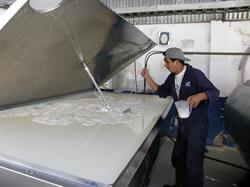 The good news was that, overall, Redding found that antibiotic use on the farms was relatively low—though higher, according to the discarded packaging, than the farmers themselves reported. In addition, antibiotics were generally only used for therapeutic purposes, which is less risky than chronic, prophylactic use when it comes to encouraging the emergence of antibiotic-resistant bacteria.
The good news was that, overall, Redding found that antibiotic use on the farms was relatively low—though higher, according to the discarded packaging, than the farmers themselves reported. In addition, antibiotics were generally only used for therapeutic purposes, which is less risky than chronic, prophylactic use when it comes to encouraging the emergence of antibiotic-resistant bacteria.
Another piece of good news that emerged from Redding’s work was that farmers were generally knowledgeable about the risks of using these drugs.
"They knew that their use posed a risk to their animals and that the products from the cow should not be sent to the milk truck,” she said.
But that wasn’t all that Redding found.
“The bad news was that they didn’t practice what they knew,” she said. “They often continued sending milk from treated cows to the milk truck, and then the milk companies tended to accept this milk.”
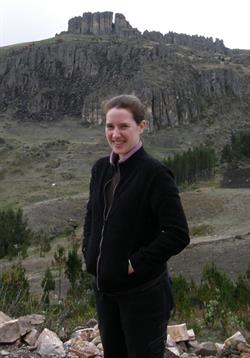 Of the farmers Redding surveyed who were treating their cows with antibiotics, she found that 92 percent continued selling that milk. And although milk companies can use a simple test to determine whether milk is contaminated, they often did so after collecting milk from many providers, at which point any contamination from a single cow’s milk would likely be diluted and undetectable.
Of the farmers Redding surveyed who were treating their cows with antibiotics, she found that 92 percent continued selling that milk. And although milk companies can use a simple test to determine whether milk is contaminated, they often did so after collecting milk from many providers, at which point any contamination from a single cow’s milk would likely be diluted and undetectable.
Also of concern were anecdotal reports of farmers selling contaminated milk on the open market as a way to avoid the milk trucks’ antibiotic testing. “There have been studies that show that milk sold on the open market has very high rates of contamination,” Redding noted.
Both the veterinarians who prescribed antibiotics and the feed store staff who sold the drugs told Redding that they instructed farmers on appropriate measures to prevent drugs from getting into the milk. Withdrawal times, or the number of days it takes a drug to clear a cow’s system, often ranged from five to seven days.
While Redding sees education as critical to improving farmers’ adherence to withdrawal times, she believes the reasons for not obeying withdrawal times and continuing to sell milk are economic in nature. Furthermore, unlike in the United States—where farmers face stiff financial penalties for failing to withhold milk from treated cows—the farmers in Cajamarca received no such penalty or only very mild ones.
“Neither the milk companies nor the farmers have the motivation to address the issue,” Redding said. “The truck companies can’t afford to lose providers because there is a lot of competition for the product, and the farmers can’t afford to lose that daily income.”
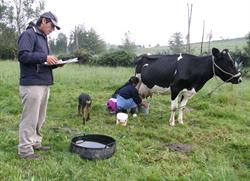 One solution, Redding said, would be to implement a system of either incentives for selling “clean” milk or a system like that in the U.S., whereby farmers get penalized for selling milk with antibiotic residues. Such a system might require government involvement to ensure high-quality animal food products.
One solution, Redding said, would be to implement a system of either incentives for selling “clean” milk or a system like that in the U.S., whereby farmers get penalized for selling milk with antibiotic residues. Such a system might require government involvement to ensure high-quality animal food products.
Another possible intervention that Redding has considered is the formation of cooperatives, an effort that has worked in other countries around the world. “Because you have more farmers contributing, there is more accountability,” she said. “It’s also a win for the milk companies because they can get a much larger volume of milk from one area instead of driving out to 20 really small farms. I would love to try to do an intervention like that in Cajamarca.”
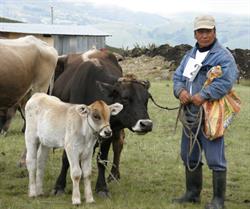 Another difference between the U.S. and places like Cajamarca is that the Peruvian farmers generally use older-generation drugs, such as oxytetracycline and penicillin, which have longer clearance times. U.S. farmers have access to—and the money to buy—newer generation drugs which have much shorter withdrawal times.
Another difference between the U.S. and places like Cajamarca is that the Peruvian farmers generally use older-generation drugs, such as oxytetracycline and penicillin, which have longer clearance times. U.S. farmers have access to—and the money to buy—newer generation drugs which have much shorter withdrawal times.
Repeatedly using the same drugs can escalate the risk of resistant strains arising. A logical follow-up study, Redding said, would be to examine the actual degree of antibiotic-resistant organisms on the Peruvian farms.
“The presumption is it’s going to be low because the use of antibiotics is infrequent,” she said. “Well, let’s test that and make sure that is the case.”
After Redding graduates, she hopes to continue exploring the issue of drug use in animal food production—a prime example of the One Health Initiative, which recognizes the inextricable links between human, animal, and environmental health. By doing so, she will be helping to ensure food quality and safety, solid livelihoods for farmers, and animal well-being. And she views her veterinary training as the essential foundation of that future work.
“The issue of animal protein is going to be hugely important in the future,” Redding said. “As incomes increase in developing countries, the demand for animal protein is going to expand exponentially in the coming years. Veterinarians have a very important role to play in making animal food production a safe process both for consumers and for the animals.”